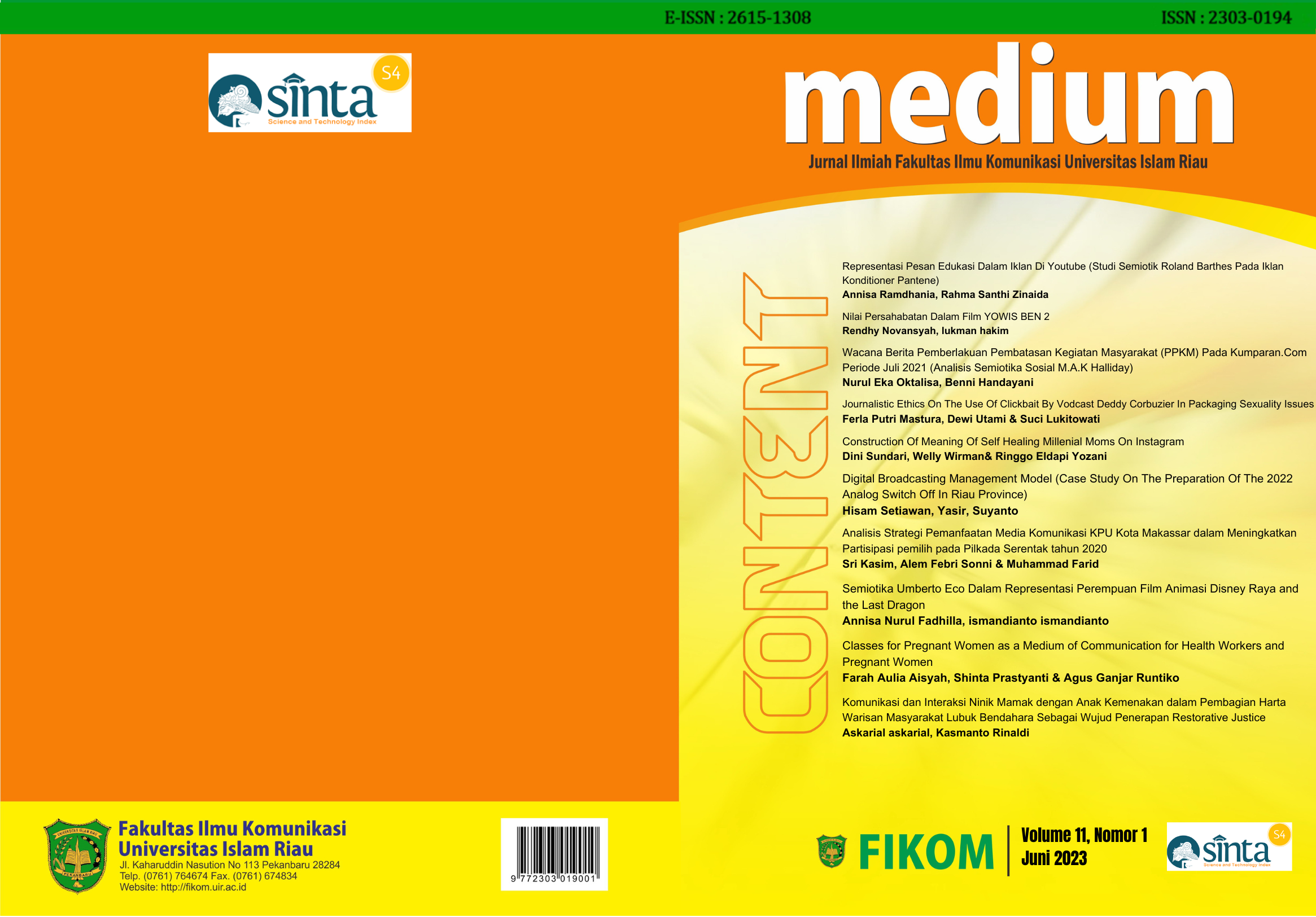Komunikasi dan Interaksi Ninik Mamak dengan Anak Kemenakan dalam Pembagian Harta Warisan Masyarakat Lubuk Bendahara Sebagai Wujud Penerapan Restorative Justice
DOI:
https://doi.org/10.25299/medium.2023.vol11(01).11053Keywords:
Ninik Mamak, Community, Inheritance, Restorative JusticeAbstract
This study aims to analyze how the role of Ninik Mamak in the distribution of inheritance in the Lubuk Bendahara community, as is known, in Lubuk Bendahara Village there is a so-called Ninik Mamak, Ninik Mamak is the elder or the leader of the tribe. Ninik Mamak has various duties not to regulate the distribution of inheritance that occurs in Lubuk Bendahara Village. This study uses a qualitative method with a descriptive approach. There are three stages that are passed in this research, namely observation, interview and documentation. based on the results obtained, namely the settlement of inheritance disputes in Lubuk Bendahara was carried out by involving Ninik Mamak. Ninik Mamak's role in the distribution of inheritance is more inclined to be considered or reduce the inheritance conflicts that occur. In the distribution of inheritance in Lubuk Bendahara, conflicts often arise, especially when left in the form of land, and there are quite a number of children left behind, so that there are often fights between siblings. Ninik Mamak's role here is as a mediator or mediator in the perceived conflict
Downloads
References
Bushar, Muhammad, (2012), Pokok-pokok hukum adat, Jakarta: PT. Pradnya Paramitha, hal 39
Bosco, F. M., Bucciarelli, M., and Bara, B. G. (2004). The fundamental context categories in understanding communicative intention. J. Pragmat. 36, 467–488. doi: 10.1016/S0378-2166(03)00055-9
Daniel, I.O.A. (2013). Communiation as socio-cultural meaning exchange. The example of Richard Wright’s Black Boy. International Journal of Applied Linguistics and English Literature, 2,5:173-177
Darwis, Rizal, (2015), Nilai – Nilai Kearifan Lokal dalam Upaya Penegakan Hukum di Indonesia (Refleksi Budaya Hayula dan Pohala’a dengan Teori Restorative Justice dalam Penyelesaian Kasus Kenakalan Remaja), IAIN Sultan Amai Gorontalo, hal 46
Departemen Pendidikan dan kebudayaan RI, (1997), Peranan Mamak Terhadap Kemenakan Dalam Kebudayaan Minangkabau, Bukit Tinggi : Pustaka Indonesia, hal 40
Esther, Naibaho, dan Christine, (2020), Mediasi Penal dalam Penanganan Pelaku Tindak Pidana Sebagai Upaya Meminimalisir Kelebihan Hunian di Lembaga Permasyarakatan, Nommensen Journal, Vol 1 No 1, hal 33
Fatimayin, Foluke, (2018), What is Communication?, School of Education, National Open University of Nigeria
Fuad, Mahsun, (2005), Hukum islam di indonesia, Yogyakarta: LkiS, hal 36
Galaway, B & J. Hudson, 1990, Criminal Justice; Restitution and Reconciliation, Monsey, NY:Criminal Justice Press, hal 2
Grice, H. P. (1975). “Logic and conversation,” in Syntax and Semantics: Speech Acts, eds P. Cole and J. L. Morgan, Cambridge, MA: Academic Press
Hakimy I, (1988), Bundo Kanduang Dan Pidato Alua Pasambahan Adat Di Minangkabau, Bandung:Remaja Rosdakrya, hal 7
Hoppler, et al, (2021), The Six Components of Social Interaction: Actor, Partner, Relation, Activities, Context and Evaluation, Frontiers in Psychology, https://doi.org/10.3389/fpsyg.2021.743074
Khrone, Marvin D, & Lane, Jodi, (2015), The Handbook of Juvenile Delinquency and Juvenile Justice, West Sussex (UK) : John Willey & Sons, hal 477
Moleong, L.J, (2011), Metode Penelitian Kualitatif, Bandung : Remaja Rosdakarya, hal 4-96
Oemarsalim, (2012), Dasar-Dasar Hukum Waris Di Indonesia, Jakarta: Rineka Cipta, hal 50
Rinaldi, Kasmanto, (2022). SISTEM PERADILAN PIDANA DALAM KRIMINOLOGI. Ahlimedia Press, hal 104
Rinaldi, K., & Adison, A. (2022). PENERAPAN HUKUM ADAT PADA KASUS PENCURIAN MADU LEBAH DI KECAMATAN BANDAR PETALANGAN KABUPATEN PELALAWAN. JLR-Jurnal Legal Reasoning, 4(2), 120-135.
Rinaldi, K. (2021). P Penerapan Restorative Justice Pada Proses Perdamaian Pelaku Dan Korban Atas Kerugian Dalam Proses Persalinan (Studi Kasus Rs X di Duri). Jurnal Hukum Das Sollen, 6(2), 46-61.
Rinaldi, K., Azhari, F., Alwafi, I., Sari, N., Nugraha, R., Putri, S. A., ... & Mianita, H. (2022). STRATEGI PENCEGAHAN EIGENRECHTING DI LINGKUNGAN MASYARAKAT. SOSIOLOGI: Jurnal Ilmiah Kajian Ilmu Sosial dan Budaya, 24(1), 75-93.
Prihatin, Dodik, (2012), Penerapan Model Restorative Justice Terhadap Anak Sebagai Tersangka Pelaku Kecelakaan Lalu Lintas di Wilayah Hukun Kepolisian Resor Jember, Universitas Jember Bagian Hukum Pidana, hal 4
Satria, Hariman, Restorative Justice : Paradigma Baru Peradilan Pidana, Jurnal Media Hukum, Vol. 25 No.1, hal 117
Shriver, Donald W. , (2013), Law, Religion and Restorative Justice in New Zealand, Cambridge University Press, Vol. 28 No. 1, Hal 153
Soepomo, (2007), Bab-Bab Tentang Hukum Adat, Jakarta: PT. Pradnya Paramitha, hal 79
Sugianto, (2017), Metode Pengolahan Data, Bandung : Bumi Aksara
Thalib .S, (1985), Hubungan hukum adat dengan hukum islam, Jakarta: Bumi Aksara, hal. 58.
Tridiatno, YA, 2015, Keadilan Restoratif, Yogyakarta : Cahaya Atma Pustaka
Van Ness & Strong, 2013, Restoring Justice : An Introduction to Restorative Justice
Widman, Stuart M. I, (2006), The Protections and Limits of Confidentiality in Mediation, Alternatives to the High Cost of Ligigation
Zulfa, Eva Achjani, (2011), Pergeseran Paradigma Pemidanaan, Bandung : Lubuk Agung, hal 74






